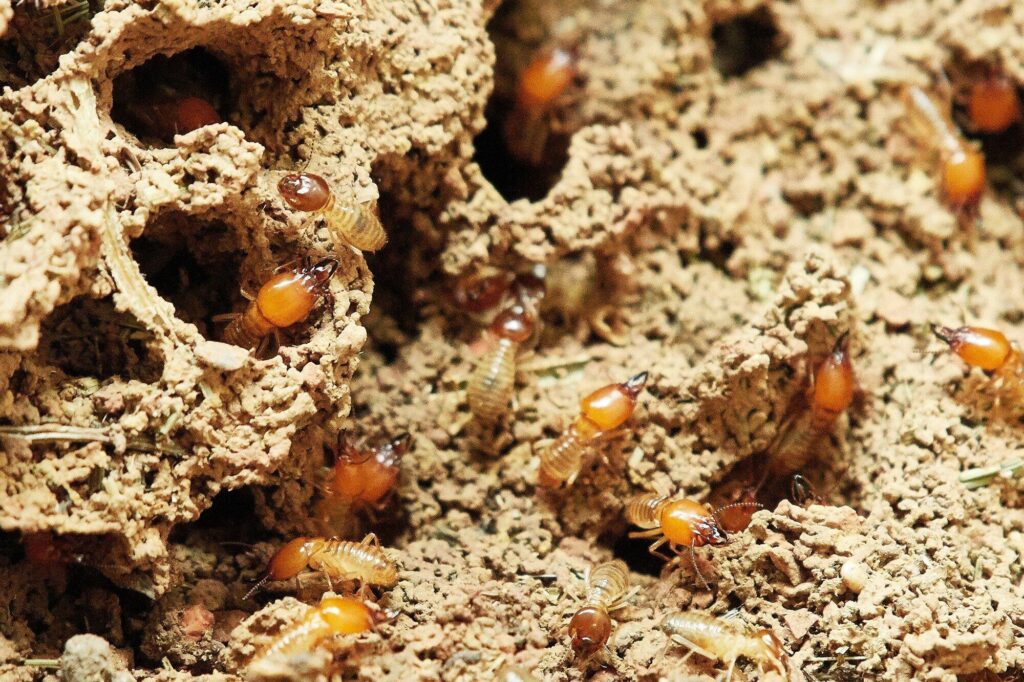Termites can cause a lot of damage to your home. Knowing how to tackle them with DIY termite control is key. In this blog post, we will explore essential tools and pest control supplies that every homeowner should have.
With the right equipment, you can take action against termites. Whether you are new to this or have some experience, these tools will help you protect your home effectively. Let’s dive into what you need for success.
Termite Bait Stations
Termite bait stations are an effective way to control termites. They are simple to use and can be very helpful for homeowners. These stations work by attracting termites, making them more likely to eat the bait.
Termite bait stations are placed in the ground around your home where termites are active. The termites eat the bait and carry it back to their colony, effectively poisoning the entire group. This process helps to reduce the termite population over time.
Regular checks of bait stations are important for success. You should monitor them to ensure they remain filled with bait. If you find termites are active, it may be time to replace the bait.
Termiticide Concentrates
Termiticide concentrates are a powerful termite treatment. They come in liquid form and are mixed with water before use and applied around your home’s foundation. These products are designed to kill termites on contact and create barriers to protect your home.
Some termiticide concentrates use natural ingredients, like orange oil, to fight termites. This makes them a safer option for homes with pets and children. Always read the label to follow the recommended safety precautions.
Using termiticide concentrates requires careful application. If termites are found, you may need to reapply the termiticide. Keeping up with this process can protect your home from damage.
Liquid Insecticide Sprayer
To apply termiticides effectively, you’ll need a liquid insecticide sprayer. This tool allows you to apply the chemical solution evenly around your home, ensuring that every potential entry point is treated. It is vital to keep termites away.
A liquid insecticide sprayer is easy to use. Fill it with the mixed solution and make sure it is sealed well. Then you can start spraying the areas around your foundation.
Make sure to cover all areas where termites might enter. Pay special attention to cracks and gaps. Regular use of the sprayer can help protect your home from further infestation.
Foam Termiticides
Foam termiticides are a valuable tool in termite control. They can get into places that other treatments cannot reach. This makes them useful for treating infestations in tight spaces.
Foam termiticides are an excellent option for hard-to-reach areas such as wall voids, cracks, and crevices. The foam expands to fill gaps, ensuring that termites hidden in discreet spots are eradicated. This helps to ensure that your treatment is more effective.
Using foam termiticides is straightforward. You can apply them using a special foam applicator. Regular treatment can help keep your home termite-free.
Borate Wood Treatments
Borate wood treatments are an effective way to protect wood structures from termite damage. These treatments penetrate the wood and stop termites from eating it. They also prevent mold and decay, making your wood stronger.
Applying borate treatments is simple. You can either brush or spray the solution on the wood. Make sure to cover all surfaces for the best results.
These treatments are safe for most indoor and outdoor uses. They do not harm pets or humans when used correctly. Regularly inspect treated wood to ensure long-lasting home protection against termites.
Termite Detection Stakes
Termite detection stakes are helpful tools for homeowners. They are easy to use and can be placed around your yard. These stakes monitor termites and indicate if they are nearby.
You insert the stakes into the ground in targeted areas. Detection stakes help determine if termites are present in certain areas before beginning more intensive treatments. This allows you to focus efforts where they are most needed.
Regular checks of the detection stakes are important. Look for signs of termite activity, like damaged wood or soil changes. Early detection can save you from costly repairs later on.
Caulking Gun and Sealant
A caulking gun and sealant are useful tools for termite control. They help fill gaps and cracks around your home. This simple step can prevent termites from getting inside.
Using a caulking gun is easy. Just load the sealant tube into the gun. Squeeze the trigger to apply the sealant where needed.
A caulking gun and sealant will help you close off potential entry points, making it harder for termites to access your home. Regularly check around windows, doors, and foundations. Keeping these areas sealed can protect your home from unwanted pests.
Moisture Meter
A moisture meter is a handy tool for termite control. It helps you find moisture in wood and soil. Termites are drawn to damp areas, so knowing where moisture is can help prevent infestations.
Using a moisture meter is easy. Simply place the probes into the material you want to test. The meter shows you the moisture level, which can guide your treatment efforts.
Regularly checking moisture levels is important. High moisture can indicate potential termite problems. Keeping areas dry helps protect your home from these pests.
Protective Gear
When working with pesticides, wearing protective gear is essential. This gear includes gloves, masks, and goggles. It helps keep you safe from harmful chemicals.
Proper clothing can also protect your skin. Long sleeves and pants are recommended to prevent direct contact. Remember to wash your clothes after using pesticides to remove any residue.
Remember, while DIY termite control can be effective for minor infestations, it’s important to recognize when the problem is beyond your expertise. If you’re unsure about handling the situation or if the infestation is severe, it’s always wise to consult with a professional exterminator. Staying safe should always be your top priority.
Take Control: Utilize DIY Termite Control for a Safer Home
DIY termite control can help protect your home from damage. By using the right tools and techniques, you can manage termite issues effectively. Regular monitoring and maintenance are key to success.
Remember to stay vigilant and check for signs of termites regularly. If the problem grows, don’t hesitate to reach out to a professional. Taking these steps now can save you money and stress in the future.
Did you find this article helpful? Visit more of our blogs.







